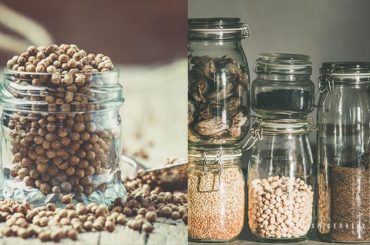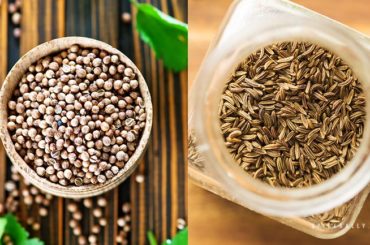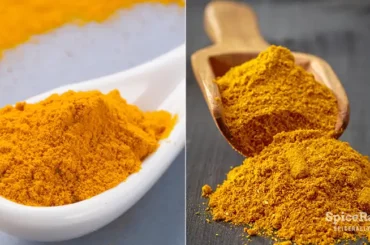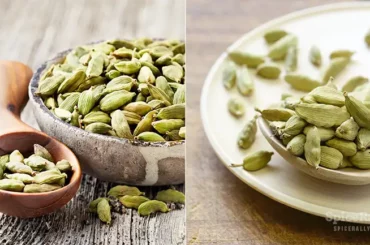Ginger and garlic go hand in hand in many recipes, especially in Asian dishes. So, most of us think that they are related. Hence, let’s see what we have to know about ginger vs garlic.
Ginger possesses a more warmly-spicy flavor with citrus, peppery and sweet undertones. But garlic is way more pungent than ginger, with sharp, nutty-sweet hints in its raw state. Accordingly, they have different aromas and distinctive characteristics.
So, continue reading if you need to learn more about these two kitchen staples.
Ginger vs Garlic- The Drilldown
| Ginger | Garlic | |
| The flavor profile | Has a mild flavor than garlic with warmly spicy, sweet, citrus, and peppery hints. Click on this link and refer to this post to learn more about ginger and its uses. | More pungent than ginger, with a sharp, nutty-sweet, earthy bite. |
| The fragrance profile | The smell of ginger is more gentle than that of garlic, with citrusy, floral, sweet, and peppery notes. | The smell of garlic is sharper and bolder than that of ginger, with earthy and sulfur notes. |
| Forms | – As fresh rhizomes – Ground – Pills/ capsules – Dried rhizomes – As teas – Powdered – Granulated – Pickled – Preserved – As an essential oil – Paste | – As whole garlic bulbs – As dried garlic chips – Powdered – Granulated – As garlic salt – Pills/ capsules – Paste – As an essential oil |
| Availability | Readily available in grocery stores, supermarkets, online shopping sites and can be grown in the home garden | Readily available in grocery stores, supermarkets, online shopping sites and can be grown in the home garden |
| Purpose in cooking | As an ingredient and condiment | As an ingredient and condiment |
| Usage in cooking | – Popular as a baking spice in Western cuisine – Widely used in curries in Asian cuisine – Incorporated into seasoning, spice blends, dry rubs, and marinades – Used to make tea – Incorporated into soups, stir-fries and stews | – Garlic powder and granulated garlic are key ingredients in many spice blends, seasoning mixtures, marinades, and dry rubs – Fresh garlic is used in curries, curry pastes, and sauces – Used in some savory baked goods like garlic bread, buns, pies, etc – Is combined with many meat and seafood dishes – Used to make garlic butter |
| General use | – In cooking and baking – As a home remedy for certain conditions – As an integral part in folk – medicine or Ayurveda – Used in modern medicine | – In cooking and baking – As a home remedy for certain conditions – As an integral part in folk medicine or Ayurveda – Used in modern medicine |
| Health benefits | – Relieves nausea from chemotherapy or morning sickness – Helps with digestive issues – Helps with weight loss and obesity – Alleviates the symptoms of osteoarthritis – Very beneficial in lowering blood sugar, and improving heart health | – Lower bad cholesterol levels, reduces high blood pressure and the risk of heart diseases – Boosts the immune system – May have potential benefits in the prevention of cancer – Prevents Alzheimer’s disease and dementia – Improves the athletic performance |
| Appearance | Is a fleshy rhizome that is grayish-light brown on the outside and pale yellow color on the inside. | It has a bulbous shape, and this bulb encloses the garlic cloves, covered with a delicate membrane that is usually pinkish-white in color. |
| Scientific name | Zingiber officinale | Allium sativum |
| Plant family | Zingiberaceae | Amaryllidaceae |
| Active compounds | – Paradols – Gingerol – Shogaols | Organosulfur compounds: – diallyl thiosulfonate – diallyl disulfide – diallyl trisulfide – E/Z-ajoene – S-allyl-cysteine – S-allyl-cysteine sulfoxide |
| Origin | Southeast Asia | The exact origin of garlic is a bit controversial. Some believe its native land is Middle Asian, while some believe it originates from West China around Tien Shan Mountains to Kazakhstan and Kyrgyzstan. |
More Insights Into The Difference Between Ginger And Garlic…
Distinctively characterized and flavored, ginger and garlic have their own special ways of adding definition to most of our favorite dishes. They are primarily used together in many Asian recipes thanks to their capability to complement each other’s flavors.
But ginger and garlic are two entirely different spices coming from diverse botanical families. Even though they derive from underground plant parts, ginger is known as a rhizome, whereas garlic is known as a bulb. Therefore, they have completely distinct appearances and textures as well.
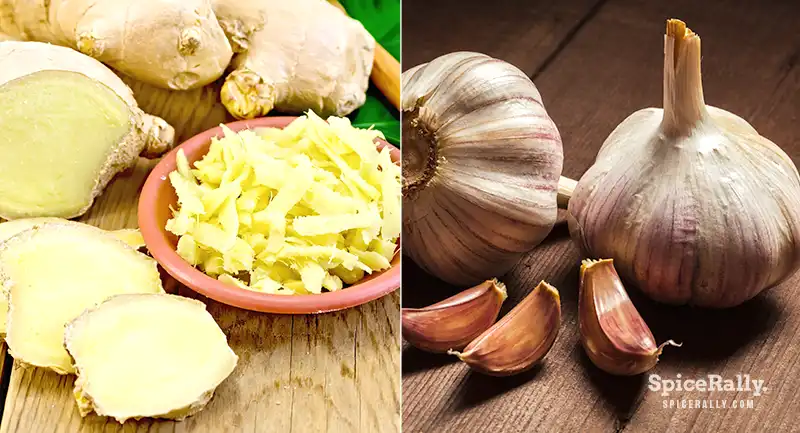
Ginger can be considered more versatile than garlic in terms of cooking. Ginger is incorporated in savory dishes, beverages, baked goods, candies, and desserts, while garlic is primarily used in savory preparations. In fact, a little garlic can go a long way, but the flavor of ginger is much less complicated when compared with garlic.
However, these ingredients are considered an essential part of Ayurveda or folk medicine, and both are being utilized in modern medicine due to their abundance of health benefits. And garlic is higher in its calorie, carbohydrate, and protein content than ginger, whereas ginger is richer in Vitamin E, Folate, and Magnesium.
Nevertheless, even though ginger and garlic are used together, they cannot be used interchangeably. But, they are often paired with the same type of ingredients in cooking.

